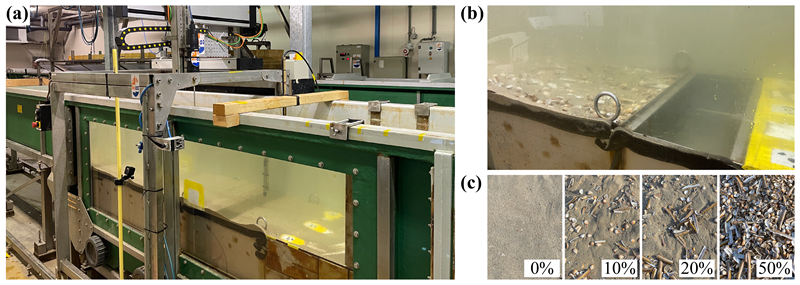S.H. Haarbosch1,2*, T.J. Kooistra2, J.W. Bosma3, S.G. Pearson1, B.C. van Prooijen1, T.J. Bouma2,3
1 Delft University of Technology; 2 Royal Netherlands Institute for Sea Research; 3 Utrecht University
*corresponding author:
Introduction
Sand nourishments have become larger in scale and more complex over the last 70 years. In the coming decades, the demands for nourishment are expected to further increase due to the rising sea levels. Therefore, it becomes increasingly important to have more-reliable sediment transport predictions to help manage the placement of sand. However, in addition to sand, large quantities of mollusc shells can also be found on the ocean floor. With increasing shell content, sand ripple dimensions are reduced and ripple migration rates slow down (Cheng et al., 2021). In essence, this limits the rate of bed-load transport. Nevertheless, there is still a need to better quantify the bed-load transport of a bed composition consisting of a sediment-shell mixture. Moreover, the shape of the shells is expected to also play a role. This study aims to gain insight into current-driven bed-load transport of a sediment-shell mixture using bivalve shells of different shapes and sizes.
Methods
Flume experiments were carried out in the racetrack flume facility at the NIOZ Royal Netherlands Institute for Sea Research (Figure 1a). The flume is equipped with a conveyer belt to generate unidirectional flow. A set of two separate experiments were conducted: (i) a slowly accelerating flow experiment to measure the influence of bivalve shells on the threshold of motion of sand particles, and (ii) a constant flow experiment to measure their influence current-driven bed-load transport (Figure 1b). In the constant flow experiment, flow velocities ranging from just below (0.25 m/s) to well-above (0.45 m/s) the threshold of motion were tested. The sediment-shell bed composition was altered in both experiments by changing the volumetric percentage of shell content. The bed compositions consisted of two different bivalve shell species: Ensis leei (elongated) and Spisula subtruncata (rounded)(Figure 1c).

Figure 1: (a) The racetrack flume. (b) Bed-load trap used during the constant flow experiments. (c) Bed composition with changing percentages of shells.
Results
Here we show preliminary results of the influence of shells on the threshold of motion of sand particles under varying bed compositions. Additionally, we quantify the bed-load transport over time for the different flow velocities. Finally, we relate this to characteristics such as particle size and shell cover. Preliminary results show that the dry-weight of the transported material reduces with the presence of shells. Moreover, we have observed an increase in shell cover over time.
References
Cheng, C. H., de Smit, J. C., Fivash, G. S., Hulscher, S. J. M. H., Borsje, B. W., and Soetaert, K. (2021). Sediment shell-content diminishes current-driven sand ripple development and migration. Earth Surface Dynamics, 9(5):1335–1346.
I. Surname1*, F.N. Another-Surname2 , Y. Next-Surname2
1 University Name, Country; 2 Organization Name, Country
* Corresponding author: mail.name@organization.org


